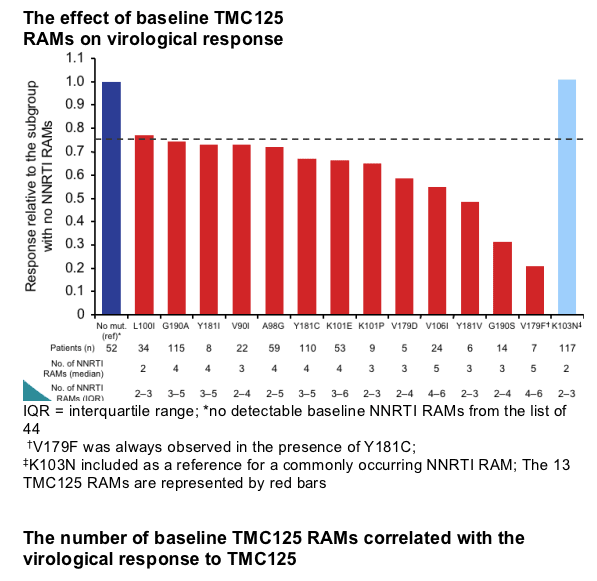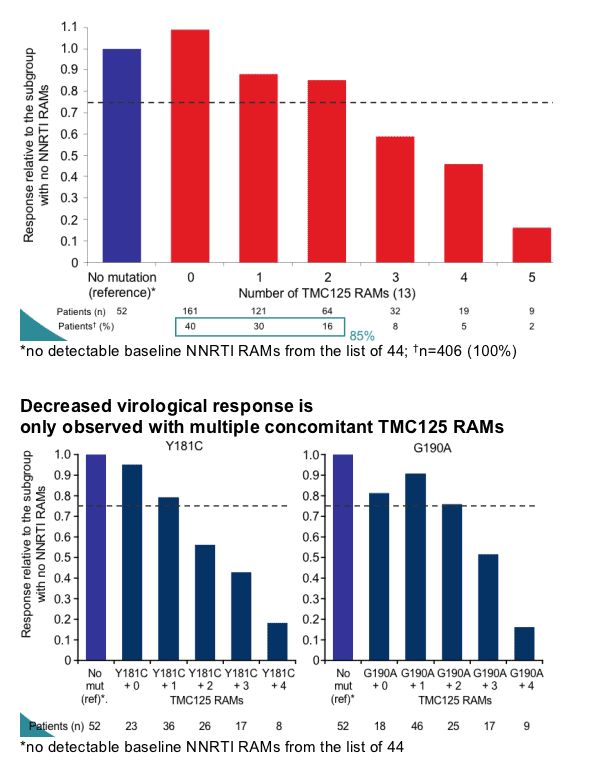 |
 |
 |
| |
Thirteen NNRTI Mutations Linked to Etravirine Resistance
|
| |
| |
XVI International HIV Drug Resistance Workshop
June 12-16, 2007
Barbados
Mark Mascolini
Tibotec researchers identified 13 nonnucleoside (NNRTI)-related mutations that blunted response to etravirine (TMC125) in the phase 3 DUET trials [1]. The most harmful mutations were among the rarest, and the worst responses to etravirine occurred in people with three or more of these mutations before beginning the new nonnucleoside. Several resistance experts at the workshop questioned the method Tibotec used to gauge the impact of various mutations on response to etravirine.
This analysis involved 406 antiretroviral-experienced (PI & NNRTI) people taking 200 mg of etravirine twice daily with other antiretrovirals--but without enfuvirtide--in DUET 1 and 2, two double-blind, placebo-controlled trials. Tibotec investigators reckoned the impact of baseline NNRTI mutations by comparing virologic responses in people with mutations and responses in people with no detectable NNRTI mutations when they started etravirine. The final analysis included 26 of 44 potential NNRTI mutations (59%) that appeared in 5 or more people when the study began.
Univariate analysis earmarked 13 mutations that muted response to etravirine in the DUET trials--V90I, A98G, L100I, K101E, K101P, V106I, V179D, V179F, Y181C, Y181I, Y181V, G190A, and G190S. Notably, this list does not include K103N, which causes high-level resistance to both efavirenz and nevirapine. Virus housing the mutation A98G, K101E, Y181C, V179F, or G190A had more additional mutations than virus without those changes. Four mutations--V179F, Y181V, V106I, and V179D--appeared in people with the worst responses to etravirine, but they were among the least common mutations, detected in 7, 14, 5, and 24 people respectively. V179F always appeared with Y181C, another critical efavirenz and nevirapine mutation.
Tibotec used a novel yardstick to compare virologic response in people with these mutations to response in people with no detectable mutations when the study began. They set the response at 1.0 for people with no detectable entry mutations and figured inferior responses as a fraction of 1.0. For example, people whose virus carried the V179F mutation had a response of about 0.3 ("response relative to the subgroup with no NNRTI RAMs, see pic of graph below) compared with the no-mutation group, and people with Y181C had a response of about 0.7.
Study participants whose virus harbored just one of the 13 identified mutations had a response of about 0.9 compared with the no-mutation group, as did people whose virus carried two of the 13 mutation. But people with three of the identified mutations had a relative response of about 0.6 and people with four of those mutations had a relative response of about 0.4. In other words, according to this type of calculation, people with one or two of the identified 13 etravirine mutations can expect some response from the drug, but people with three of more of those mutations have significantly reduced response (see pic of graph below). And Tibotec figured that 85% of the people they studied had 0, 1, or 2 of the 13 critical mutations.
But several workshop attendees had qualms about the reliability of this method, including Charles Boucher (University Hospital Utrecht), Daniel Kuritzkes (Brigham and Women's Hospital Boston), and Jonathan Schapiro (National Hemophilia Center, Israel). Schapiro observed that one entry criterion for the trial was at least one NNRTI mutation at screening for the trial or in an earlier resistance test. In other words, the comparison group of people with undetectable NNRTI mutations at screening had such mutations at some point and possibly had one or more NNRTI mutations at low levels in blood or cells when they were screened for the trial. Thus it becomes difficult to figure out what a relative response of 0.9 or 0.5, for example, actually means. (note from Jules: I'm not convinced these objections were valid. Once we see the efficacy results in Sydney these "relative responses" will I think make sense, we'll see in 1 month).
Susceptibility to etravirine--measured as fold change in 50% effective concentration (EC50)--decreased in a stepwise fashion as the number of mutations in a baseline sample rose. As one would expect, virologic response to etravirine also fell as the number of mutations mounted.
Efficacy results in the DUET trials will be unveiled at the July IAS meeting in Sydney.
Barcelona clinicians determined that mutations linked to poor response to etravirine in earlier studies appear relatively rarely after failure of efavirenz or nevirapine [2]. Bonaventura Clotet (irsiCaixa Foundation, Barcelona) and colleagues predicted that "complete resistance to etravirine will be very rare, but low-to-intermediate resistance will be fairly common."
The mutations used in this analysis did not mesh precisely with those in the latest Tibotec study, described above [1]. The Barcelona team considered viral samples sent for resistance testing from 1998 through 2006 and including the hallmark NNRTI mutations K103N, Y181C, G190A, or V108I. Then they tallied the number of etravirine-related mutations in those viral samples. On the basis of earlier reports, they defined high-level resistant virus (more than a 10-fold change in susceptibility) as virus containing F277C, Y181I, or V179F alone--or K101P, V179E/I, Y181I/V, G190S, or M230L plus two additional mutations. The Barcelona team considered Y181C, V179D, K101E, and Y188L plus two additional mutations as changes that confer intermediate (5- to 10-fold) resistance to etravirine.
Overall, 56% of the 1586 viral samples studied contained one or more mutations from this list. But many of these mutations or groups of mutations were considered to confer intermediate resistance to etravirine. The critical mutations F227C, V179F, or Y181I alone appeared in only 0.1%, 0.3%, and 4% of the viruses studied. The researchers saw K101P plus two other mutations in no viral isolates, Y181V plus two other mutations in 0.1%, V179E plus two other mutations in 0.2%, M230L plus two other mutations in 0.4%, G190S plus two other mutations in 0.9%, Y181I plus two other mutations in 1%, and V179I plus two other mutations in 5.8%. No viral samples harbored these mutations with four other NNRTI mutations.
Among mutation sets judged to confer intermediate resistance to etravirine, V179D plus two other mutations appeared in 1% of viral isolates, Y188L plus two others in 6%, K101E plus two others in 10%, and Y181C plus two others in 13.4%. The mutations V179E/F/I/D, or Y181I/V/C, or K101P/E, or G190S, or M230L, or F227C, or
Y188L showed up in only four viral samples (0.2%).
References
1. Vingerhoets J, Buelens A, Peeters M, et al. Impact of baseline NNRTI mutations on the virological response to TMC125 in the phase III clinical trials DUET-1 and DUET-2. Antiviral Therapy. 2007;12:S34. Abstract 32.
2. Llibre JM, Santos JR, Puig T, et al. Prevalence of etravirine-associated mutations in
clinical samples with resistance to nevirapine and efavirenz. Antiviral Therapy. 2007;12:S74. Abstract 65.
"Impact of Baseline NNRTI Mutations on the Virologic Response to TMC125 in the Phase III Clinical Trials DUET-1 and DUET-2"
J Vingerhoets, Tibotec
OBJECTIVES
To identify the baseline genotypic determinants of decreased virological response to TMC125, in the
Phase III DUET-1 and DUET-2 trials (pooled data)
To provide guidance in the interpretation of genotypic resistance information related to TMC125
METHODS
Effect of baseline genotype on the virological response to TMC125 at Week 24, was studied in the subgroup of patients not using enfuvirtide as a new drug, and excluding the patients who discontinued for other reasons than virological failure (n=406).
Virological response at Week 24 is presented relative to the response achieved by the subgroup of patients without detectable NNRTI RAMs at baseline* (n=52; relative response = 1.0)
(*patients had NNRTI mutations from previous genotype)
Decreased virological response was defined as a response that was at least 25% lower than that of the subgroup of patients without detectable NNRTI RAMs at baseline, using the primary efficacy endpoint of confirmed viral load <50 HIV-1 RNA copies/mL
RT mutations were included in the analysis if they were present at baseline in 5 or more patients


AUTHOR CONCLUSIONS
Using the pooled data from DUET-1 and DUET-2, thirteen baseline RT mutations were associated with resistance to TMC125:
- V90I, A98G, L100I, K101E/P, V106I, V179D/F, Y181C/I/V, G190A/S
- 85% of the subjects had 0, 1 or 2 TMC125 RAMs,
only 15% had 3 or more TMC125 RAMs
- the TMC125 RAMs occurred mainly in the presence of other NNRTI RAMs
The number of baseline TMC125 RAMs was associated with a decreased virologic response to TMC125:
- The largest impact on virologic response was observed in the subgroup of patients with 3 or more TMC125 RAMs
These data provide guidance in the interpretation of genotype resistance data related to TMC125
|
| |
|
 |
 |
|
|